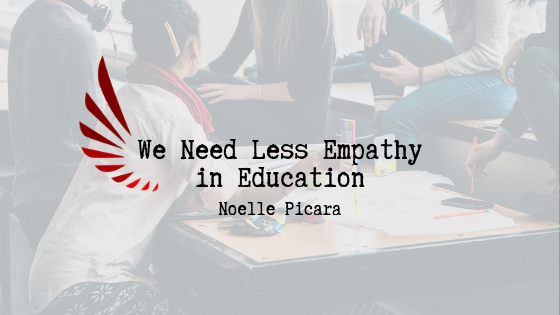There is a buzzword in education and especially design-thinking centered education that is defining the way that teachers interact with their students. That word is empathy. As teachers, we are called to empathize with our students because when we do, we feel as though there is more peace in the world and equity in our classrooms. But I challenge you to think differently. Empathy is not the answer – compassion is.
Paul Bloom describes empathy as an “emotion that we have, [that] is largely irrational.” But why is empathy, especially empathy in education, considered irrational? Let’s take a closer look at classroom dynamics.
In his book, “For White Folks Who Teach in the Hood – And The Rest of Y’all too,” Dr. Christopher Emdin discusses how teachers will often pay more attention to students who are like them. This leads to better grades, less discipline, and more time spent with students who remind them of themselves. For example, I am a performer at heart and in my classroom, loud and seemingly boisterous students do very well. This is partially because I can relate to them and their energy.
Empathy creates problems in education and can actually lead to inequality in your classroom. Paul Bloom defines empathy as putting yourself into someone else’s shoes. Humans are only able to put themselves in the shoes of experiences that they understand. This is what leads to implicit bias in teachers. They will lean towards identifying more with students who are like them, whether that is the same race as them, the same socioeconomic standing, the same gender, or the same temperament. This preferential treatment is detrimental in a profession that requires equity.
Empathy can not only be hurtful in teacher-student relationships but also in students’ problem-solving. As teachers, we expect our own students to be able to empathize with others, such as those who have been incarcerated, when they may not be able to. When I produced Unwarranted: The Human Cost of Fines, many students, before meeting members of the impacted community, imagined incarceration based only on what they knew from movies and stereotypes.
This problem of empathy spreads much larger than education. It is heavily ingrained in nonprofits and volunteering culture. Social justice work often becomes people, imagining what it must be like to be in another position, feeling bad and wanting to make a difference. This leads them to actions that often add more harm than good to the situation but at least they feel better at the end of it. Kate Krukiel, in her TEDx talk, likens this to “giving a bald man a hairbrush.”
Roshi Joan Halifax talks about this phenomenon in her book “Standing On The Edge” and refers to it as pathological altruism: the process of wanting to help people so much that it becomes pathological. At this point, empathy either becomes detrimental to yourself, or it simply makes you feel better without helping the other person. This can strengthen the case against empathy and pushes a better principle: compassion.
Empathy often gets us into trouble. Assuming we know what a friend, family member, or significant other is thinking or feeling, only to be wrong. This puts us in a sticky situation. And in the classroom, it is even more dangerous.
The kids in our classroom are not only hailing from different cultural backgrounds, but they are also coming from a different generational perspective. It becomes quite problematic for us to claim empathy with these students. Instead, we are paving a way to make and hold onto biased decisions.
Almost 80% of teachers are white. This statistic, coupled with empathy, leads to white students having different standards and priveledges. Students of color are often held to a much higher and much stricter standard. Discipline is doled out more freely and patience is withheld.
Empathy in teaching often comes from a place of emotion. Although we love our students, we cannot teach simply with our emotions because when we do, we end up being at the mercy of our empathy bias.
We need to set expectations for our students and believe in them to live up to them. Students will act how we treat them and if we spend time empathizing, we will miss really seeing who our students truly are and what they have to teach us. Above all, we need to set high standards and do the difficult work of holding that line, giving support with equity and compassion for each one of our students.

